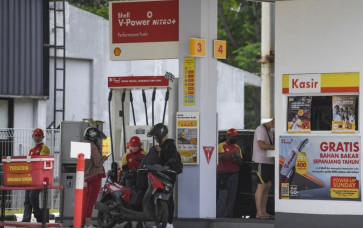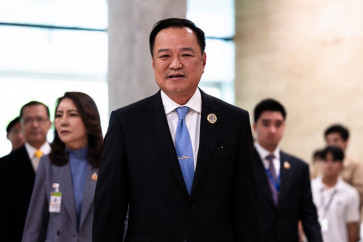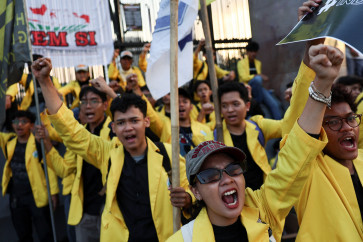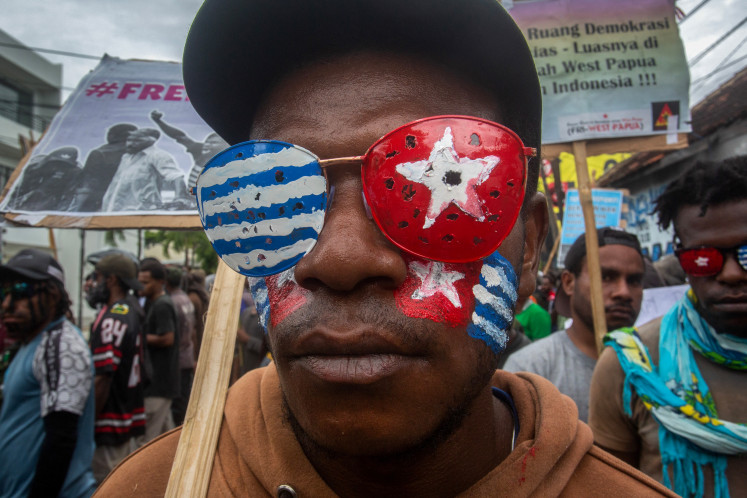Popular Reads
Top Results
Can't find what you're looking for?
View all search resultsPopular Reads
Top Results
Can't find what you're looking for?
View all search resultsPutu Oka Sukanta and poetry from prison
Unbowed: Sukanta at the launch of his collection of oral histories about the violence in 1965-1966
Change text size
Gift Premium Articles
to Anyone
 Unbowed: Sukanta at the launch of his collection of oral histories about the violence in 1965-1966. âWe are beginning to have the courage to break the silence. Even if those in power still refuse to listen.â (Zoe Reynolds)" height="382" border="0" width="512">Unbowed: Sukanta at the launch of his collection of oral histories about the violence in 1965-1966. âWe are beginning to have the courage to break the silence. Even if those in power still refuse to listen.â (Zoe Reynolds)
Unbowed: Sukanta at the launch of his collection of oral histories about the violence in 1965-1966. âWe are beginning to have the courage to break the silence. Even if those in power still refuse to listen.â (Zoe Reynolds)" height="382" border="0" width="512">Unbowed: Sukanta at the launch of his collection of oral histories about the violence in 1965-1966. âWe are beginning to have the courage to break the silence. Even if those in power still refuse to listen.â (Zoe Reynolds)Putu Oka Sukanta survived one of the greatest atrocities in Indonesia during the violence of 1965-1966. In this two-part series, Zoe Reynolds writes how the internationally recognized Balinese writer â and others silenced under Soeharto âused the arts to voice opposition to persecution and injustice.
I gaze at the Statue of Liberty
And think of poetry written in prison.
â Sukanta, âStatue of Libertyâ
So wrote Balinese poet Putu Oka Sukanta on a visit to New York in 2000. Now Sukanta writes from his home in East Jakarta, with funding from a Hellman/Hammett grant for courage in the face of persecution.
The grant, by the New York-based Human Rights Watch, is named for the late American playwright Lillian Hellman and companion, novelist Dashiell Hammett. Both were persecuted during the McCarthy Communist witch hunt in the US in the 1950s.
Like Hellman and Hammett, Sukanta, now 74, was a victim of the Cold War.
Sukantaâs writings, spanning five decades â two novels, short stories, essays, oral histories and documentaries â document how many artists found inspiration from the hell of incarceration â and how they could not be silenced.
He is foremost among the artists, writers, teachers, journalists and labor leaders who survived the 1965 Communist purge that followed the ouster of the Sukarno government and saw the ascension of Soeharto.
 Portrait of the artist: Putu Oka Sukanta reading poetry in high school in Bali in the 1950s. When he was 16, Sukanta was already publishing his writings in newspapers and magazines in Bali and Java. (Courtesy Putu Oka Sukanta)
Portrait of the artist: Putu Oka Sukanta reading poetry in high school in Bali in the 1950s. When he was 16, Sukanta was already publishing his writings in newspapers and magazines in Bali and Java. (Courtesy Putu Oka Sukanta)
Yet Sukanta was not among his colleagues huddled in the pressroom of the National Human Rights Commission (Komnas HAM) in July 2012, when it released its 468-page report into the mass killings that followed the purge.
âI have my work to do,â Sukanta said. âThe President will not apologize,â he said, referring to Susilo Bambang Yudhoyono. âThe perpetrators will not be imprisoned.â
Sukanta grew up in Singaraja in Buleleng, North Bali, as one of five children. His mother and father were illiterate small farmers and he was the first in his generation to go to school. âBefore the Revolution under the Dutch, only the rich could afford to send their children to school,â Sukanta recalls.
When he was 16, Sukanta was publishing his writings in newspapers and magazines in Bali and Java such as Suara Indonesia, Balai Pustaka, and Waspada. He went on to study and then lecture at Tamansiswa University in Yogyakarta
In 1965, Sukanta was teaching at a private high school in Koja, Jakarta, living with artists and writers associated with the Peopleâs Institute of Culture (Lekra), although he said that he himself was not a member.
Lekra was associated with the Indonesian Communist Party (PKI), which in turn was an arm of the government. Like the Hindu god Brahma, Sukarno had many arms at play â nationalism, religion and communism â known by the acronym nasakom.
Sukarno had declared that Indonesia would move toward a socialist economy. Eighty percent of industry had already been nationalized. But the brutal repression of the PKI after they were alleged to have launched the abortive coup of Sept. 30, 1965 changed everything.
It is said the âthree greensâ turned the rice fields of Bali and beyond red, referring to then-US ambassador to Indonesia Marshall Green, the green of the Indonesian Army and the green of Islam. Muslims were told that the PKI members were kafir, or infidels, and were urged to wage a holy war against them.
They cut down at night,
They set fire at night,
They run amok, day and night
And I was one who ran helter skelter
â Sukanta, from a poem performed in 2011
The figures on how many were killed in the ensuing violence vary wildly â from half a million, according to the CIA, to three million, according to the late Sarwo Edhie Wibowo, President Yudhoyonoâs father-in-law, who headed the military campaign at the time as commandant of the Armyâs Special Forces.
âThe conservative estimate is 80,000 dead in Bali alone,â said Adrian Vickers, professor of Southeast Asian studies at the University of Sydney.
âBali and East Java had the most intense killings. But whenever people have tried forensic research in Bali they have been blocked. Even now, people doing any study on the killings are harassed by the police,â Vickers said in a telephone interview.
 Unbowed: <)
Unbowed: <)
U
span class="caption" style="width: 510px;">Unbowed: Sukanta at the launch of his collection of oral histories about the violence in 1965-1966. 'We are beginning to have the courage to break the silence. Even if those in power still refuse to listen.' (Zoe Reynolds)
Putu Oka Sukanta survived one of the greatest atrocities in Indonesia during the violence of 1965-1966. In this two-part series, Zoe Reynolds writes how the internationally recognized Balinese writer ' and others silenced under Soeharto 'used the arts to voice opposition to persecution and injustice.
I gaze at the Statue of Liberty
And think of poetry written in prison.
' Sukanta, 'Statue of Liberty'
So wrote Balinese poet Putu Oka Sukanta on a visit to New York in 2000. Now Sukanta writes from his home in East Jakarta, with funding from a Hellman/Hammett grant for courage in the face of persecution.
The grant, by the New York-based Human Rights Watch, is named for the late American playwright Lillian Hellman and companion, novelist Dashiell Hammett. Both were persecuted during the McCarthy Communist witch hunt in the US in the 1950s.
Like Hellman and Hammett, Sukanta, now 74, was a victim of the Cold War.
Sukanta's writings, spanning five decades ' two novels, short stories, essays, oral histories and documentaries ' document how many artists found inspiration from the hell of incarceration ' and how they could not be silenced.
He is foremost among the artists, writers, teachers, journalists and labor leaders who survived the 1965 Communist purge that followed the ouster of the Sukarno government and saw the ascension of Soeharto.
Portrait of the artist: Putu Oka Sukanta reading poetry in high school in Bali in the 1950s. When he was 16, Sukanta was already publishing his writings in newspapers and magazines in Bali and Java. (Courtesy Putu Oka Sukanta)
Yet Sukanta was not among his colleagues huddled in the pressroom of the National Human Rights Commission (Komnas HAM) in July 2012, when it released its 468-page report into the mass killings that followed the purge.
'I have my work to do,' Sukanta said. 'The President will not apologize,' he said, referring to Susilo Bambang Yudhoyono. 'The perpetrators will not be imprisoned.'
Sukanta grew up in Singaraja in Buleleng, North Bali, as one of five children. His mother and father were illiterate small farmers and he was the first in his generation to go to school. 'Before the Revolution under the Dutch, only the rich could afford to send their children to school,' Sukanta recalls.
When he was 16, Sukanta was publishing his writings in newspapers and magazines in Bali and Java such as Suara Indonesia, Balai Pustaka, and Waspada. He went on to study and then lecture at Tamansiswa University in Yogyakarta
In 1965, Sukanta was teaching at a private high school in Koja, Jakarta, living with artists and writers associated with the People's Institute of Culture (Lekra), although he said that he himself was not a member.
Lekra was associated with the Indonesian Communist Party (PKI), which in turn was an arm of the government. Like the Hindu god Brahma, Sukarno had many arms at play ' nationalism, religion and communism ' known by the acronym nasakom.
Sukarno had declared that Indonesia would move toward a socialist economy. Eighty percent of industry had already been nationalized. But the brutal repression of the PKI after they were alleged to have launched the abortive coup of Sept. 30, 1965 changed everything.
It is said the 'three greens' turned the rice fields of Bali and beyond red, referring to then-US ambassador to Indonesia Marshall Green, the green of the Indonesian Army and the green of Islam. Muslims were told that the PKI members were kafir, or infidels, and were urged to wage a holy war against them.
They cut down at night,
They set fire at night,
They run amok, day and night
And I was one who ran helter skelter
' Sukanta, from a poem performed in 2011
The figures on how many were killed in the ensuing violence vary wildly ' from half a million, according to the CIA, to three million, according to the late Sarwo Edhie Wibowo, President Yudhoyono's father-in-law, who headed the military campaign at the time as commandant of the Army's Special Forces.
'The conservative estimate is 80,000 dead in Bali alone,' said Adrian Vickers, professor of Southeast Asian studies at the University of Sydney.
'Bali and East Java had the most intense killings. But whenever people have tried forensic research in Bali they have been blocked. Even now, people doing any study on the killings are harassed by the police,' Vickers said in a telephone interview.
Nightmare: 'When the graveyards lit up at night you knew the killings were under way,' said Raka Suwasta. The Balinese painter was designing political posters before his arrest late one night by soldiers. (Zoe Reynolds)
An estimated one in 20 Balinese died, typically unarmed, at the hands of vigilante groups dressed in black and armed with machetes and swords between December 1965 and March 1966.
'When the graveyards lit up at night you knew the killings were under way,' said Balinese painter Raka Suwasta. 'I saw the lights walking home to Denpasar one night and fled. Then the military came. There was a knock on the door. They took me away.'
Suwasta now lives on the other side of Ubud's Monkey Forest. In 1965, he was designing political posters ' something he now regrets.
'Art should be pure,' Suwasta said, seated among framed oils of flowers and dancers in his studio. 'Politics can ruin art. It should be objective. Like journalism, don't you think?'
There is little objectivity in the accounts of 1965-66. The official version is a very different from the stories told by the victims of the purge. The generals who ruled Indonesia until the fall of Soeharto in 1998 point to the murder of six of their own in the bloody killings at Lubang Buaya (Crocodile Hole) in East Jakarta and the abortive coup.
Others, such as Peter Dale Scott, a former Canadian diplomat and a professor at the University of California, claim that a dalang (or puppet master) ' maybe the CIA, maybe Soeharto ' was manipulating the events that led to Lubang Buaya to justify the bloodletting to come.
'The academic jury is still out on that one,' Akihisa Matsuno, a professor who studies Indonesia at Osaka University in Japan, said in an interview. 'We still don't have enough evidence to conclusively support either version. But there are no doubts about the Indonesian Army's involvement and US support for the civilian massacres to follow.'
The US provided arms, communications and logistics during the mass killings, The Washington Post reported. At the height of the bloodbath, embassy cables showed Green assuring Soeharto. 'The US is generally sympathetic with and admiring of what the army is doing.'
After the slaughter, an estimated two million women and men had been imprisoned and detained without trial.
Sukanta was among them.
A soldier on guard at gate 5
bland smile, fiery jackal eyes
Behind gate 7 a heap of souls incarnated as numbers
' Sukanta, 'The Face of Salemba'
In the second article in this series, Reynolds will explore the fate of the artists in prison and after their release.










